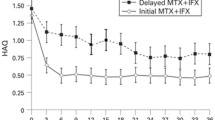Abstract
The last decade has seen a marked increase in the elucidation of cellular and molecular factors involved in chronic inflammatory processes that contribute to the pathogenesis of rheumatoid arthritis (RA). Multiple lines of evidence have demonstrated a critical role for the proinflammatory cytokine tumor necrosis factor (TNF) in the perpetuation of inflammatory synovitis and the subsequent destruction of cartilage and bone that leads to the functional disability observed in RA. In the light of these discoveries, new therapeutics have been developed to target TNF. The consistent efficacy demonstrated by these agents for the treatment of RA has validated TNF as an important mediator of the chronic inflammatory events and structural damage that occur with the disease. Three of these agents (etanercept, infliximab, and adalimumab) have been approved by the United States Food and Drug Administration (FDA) over the last 5 years for treatment of moderately to severely active RA. This article will first explain the role of TNF in inflammation and RA, and then compare and contrast the mechanisms of action, efficacy, and safety profiles of the various FDA-approved TNF inhibitors, as well as offer potential explanations for the clinical differences observed between these agents, especially with regard to safety.
Similar content being viewed by others
Author information
Authors and Affiliations
Corresponding author
About this article
Cite this article
Weaver, A. Efficacy and safety of the anti-TNF biologic agents. Mod Rheumatol 14, 101–112 (2004). https://doi.org/10.1007/s10165-004-0275-8
Issue Date:
DOI: https://doi.org/10.1007/s10165-004-0275-8



